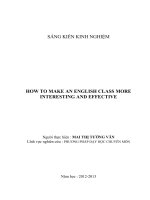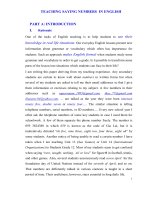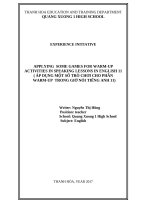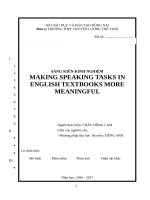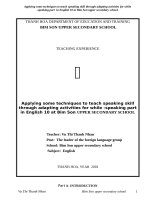skkn MAKING SPEAKING TASKS IN ENGLISH TEXTBOOKS MORE MEANINGFUL
Bạn đang xem bản rút gọn của tài liệu. Xem và tải ngay bản đầy đủ của tài liệu tại đây (149.96 KB, 21 trang )
SỞ GIÁO DỤC VÀ ĐÀO TẠO ĐỒNG NAI
Đơn vị TRƯỜNG THPT CHUYÊN LƯƠNG THẾ VINH
Mã số: ................................
SƠ LƯỢC LÝ LỊCH KHOA HỌC
––––––––––––––––––
THÔNG TIN CHUNG VỀ CÁ NHÂN
I.
1.
Họ và tên: CHÂU HỒNG LAM
2.
KIẾN KINH NGHIỆM
Ngày tháng nămSÁNG
sinh: 18/08/1983
3.
Nam, nữ: Nữ
5.
MAKING SPEAKING TASKS IN
ENGLISH TEXTBOOKS MORE
Địa chỉ: 468/19/5, P. Tân Hiệp, Biên Hòa, Đồng Nai
MEANINGFUL
Điện thoại:
(NR);
ĐTDĐ: 01223953854
6.
Fax:
7.
Chức vụ:
8.
Nhiệm vụ được giao: Giảng dạy và chủ nhiệm lớp chuyên Anh
9.
Đơn vị công tác: Trườ
ng THPT
Lương
Thế Vinh
Người
thực Chuyên
hiện: CHÂU
HỒNG
LAM
•
TRÌNH ĐỘ ĐÀO Lĩnh
TẠO vực nghiên cứu:
- Phương pháp dạy học bộ môn: TIẾNG ANH
Học vị cao nhất: Thạc sỹ
•
Năm nhận bằng: 2007
4.
II.
•
E-mail:
Có đính kèm:
Chuyên ngành đào tạo: Phương pháp giảng dạy
Mô hình
Phần mềm
Phim ảnh
KINH NGHIỆM KHOA HỌC
III.
•
Hiện vật khác
Lĩnh vực chuyên môn có kinh nghiệm: giảng dạy Tiếng Anh
Số năm có kinh nghiệm: 12 năm
Năm học: 2016 - 2017
1
•
Các sáng kiến kinh nghiệm đã có trong 5 năm gần đây:
√
CONTENTS
I. RATIONALE
II. IMPLEMENTATION
A. LITERATURE REVIEW
B. METHODOLOGY
1. Students’ preferences for speaking activities
2. Sample lesson plans
UNIT 1
UNIT 4
UNIT 8
UNIT 9
UNIT 12
UNIT 13
III. CONCLUSION AND RECOMMENDATIONS
IV. REFERENCES
2
MAKING SPEAKING TASKS IN ENGLISH TEXTBOOKS MORE MEANINGFUL
I. RATIONALE
It is undeniable that Vietnamese high school students often get bored and
distracted during speaking lessons. Having speaking skill integrated into
high school English textbooks is really a great innovation, showing the
awareness of the importance of being able to communicate when learning a
foreign language. However, speaking task designers have not done a good jod
in encouraging students to open their mouths because they see no point in
doing so, or in other words, they have not been given the motivation to
speak.
Motivation plays a significant role in the process of learning a language.
However, the authors of the textbooks did not seem to recognise this when
designing speaking tasks, which are not meaningful enough to get learners
involved in the lessons. Learners need quality instruction, input, interaction,
and opportunities for meaningful output, not only to make progress, but also
to maintain motivation for language learning. A good teacher, then, must tap
into the sources of intrinsic motivation and find ways to connect them with
external motivational factors that can be brought to a classroom setting.
In the scope of this paper, the author attemps to adapt 6 speaking lessons in
English textbook 10 to make the tasks more relevant to learners.
II. IMPLEMENTATION
A. LITERATURE REVIEW
3
According to the result of an ESL workshop about scaffolding, ‘an ESL
student who is nervous or bored in class will learn neither subject content
nor new language, even if the input is comprehensible’ and ‘the purely oral
scaffolding undertaken by the teacher is not enough’; therefore, ‘visual
scaffolding is an excellent way to provide comprehensible input to ESL
students so that not only will they learn the essential subject content but also
they will make progress in their acquisition of English.’ Besides, Jeremy
(1998, p. 88) states that ‘good speaking activities can and should be highly
motivating. If all the students are participating fully – and if the teacher has
set up the activity properly and can then give sympathetic and useful
feedback – they will get trememdous satisfaction from it.’
Therefore, at the beginning of any speaking lesson, teachers should expose
students to inspiring, motivating, and above all, authentic materials like the
videos I use in most of my speaking lessons and get students engaged in real
life situations. Besides, scaffoding is also of utmost importance in language
acquisition, and videos serve this purpose best as they can provide the
students with both inspiration and the target language that can boost the
students’ confidence in speaking.
Jack and Will (2002, p. 364) states, a teacher ‘selects the video, relates the
video to students’ needs, promite active viewing, and integrates the video
with other areas of the language curriculum’ to increase the ‘chances of
achieving the important goals of motivating students’ interest, providing
realistic listening practice, stimulating language use, and heightening
stuents’ awreness of particular language points or other aspects of
communication’ because ‘scenes with a high degree of visual support are
more useful for presenting language.’ It is also emphasised that teachers can
bring in the video to introduce or to expand on a theme or topic that is
already part of the curriculum or that is dealt with in the students’ textbook
(Jack and Will, 2002). They aso add that ‘teachers can promote active
viewing and increase student comprehension and recall by planning videorelated lessons for three stages of activity: previewing, viewing, and
postviewing’ because ‘these prepare the students to watch the video by
tapping their background knowledge, stimulating interest in the topic, and
lessening their fear of unfamiliar vocabulary.’ Jack and Will (2002, p. 366)
B. METHODOLOGY
Subjects
The subjects of the study are 27 students from class 10 English 2 and 25
students from class 10 Mathematics, Luong The Vinh Specialised High School
4
in the school year 2016-2017. Generally speaking, all the 30 students are
rather good at English. However, most of them seem reluctant to speak
English.
Research instruments: questionnaire, experimental teaching,
observation.
Procedures
1. Students’ preferences for speaking activities
Order these activities from most motivating to least motivating to you in
speaking lessons
No Activites
.
Orde
r
1
Studying sentence structures
2
Being provided with a list of topical language
3
Oral instruction by the teacher
4
Pictures/posters related to the topic
5
Speaking activities in the textbook
6
Listening to a sample conversation
7
Watching a video related to the topic
From the data collected, the author finds out that most of the students (more
than 90%) state that watching a video related to the topic is a great source of
inspiration for their own speaking. The next positions belong to listening to
a sample conversation and pictures/posters related to the topic. In contrast,
100% of the students find speaking activities in the text book the most boring,
putting it at the bottom of the least. Number 1, 2, 3 are not very helpful in
engaging the students in speaking activities.
2. Sample lesson plans
Unit 1
5
MY WEEKEND MORNING ROUTINE
Level: Intermediate
Aim: a mingle activity with emphasis on oral fluency; students practise
making a monologue about their weekend morning routine.
Language point: expressions to use for describing everyday activities;
rhythm and stress when giving important information.
Materials: a sample clip in which a girl talks about her weekend morning
routine
WARM-UP
Write on the board: A DIFFERENT ME
Ask the students if they would like to know about a different aspect of their
classmates.
Ask five pairs of students (it is better if the pairs are deskmates or best
friends) to come to the front.
Give one member in each pair a piece of paper and a pencil to draw their
favourite activity on a day off school, and ask the other to guess what it is
without looking at the drawing.
Then check if the answers and the drawing really match.
Write some ‘abnormal’ activities on the board.
PRE-SPEAKING
Have the class watch a short clip in which a girl talks about her weekend
morning routine.
Ask the students to note down some expressions used to describe daily
activities and some connectors used in the clip.
Elicit the phrases and write on the board.
Sleep in
Wake up
Check my phone
Enjoy my morning
Hello world
Get onto my laptop
6
Get my lazy butt up
Head back upstairs
Change into my clothes
Make my bed
Take a shower
Do my makeup
Head downstairs
To heat up
Make some coffee/can’t
live without coffee
Hop into the shower
Put
on
my
moituriser/concealer
Let out my dog
Exfoliate my skin
7
Curl my lashes
WHILE-SPEAKING
Ask individual students to make an outline of their own weekend morning
routine. Ask students to talk to their partners.
Ask some students to come to the front and talk about their weekend morning
routine.
Ask the others to take notes of the activities mentioned and connectors.
Take notes of language errors good use of the target language, but don’t
correct at this point.
POST-SPEAKING
Ask the students if they have found anything surprising about their friends.
Do a quick feedback on the errors or language you took notes on.
Ask the students to come home a make a video clip of their own.
Unit 4
MY SOURCE OF INSPIRATION
Level: Intermediate
Aim: a mingle activity with emphasis on oral fluency; students practise
describing incredible figures
Language point: expressions to use for describing describing incredible
figures; rhythm and stress when giving important information.
Materials: a clip of a disabled girl
WARM-UP
Write on the board: BORN DIFFERENT
Have the class watch a short clip in which a girl amazingly adapts to life
despite her disabolity
Ask the students to note down some expressions used to describe incredible
figures
8
Elicit the phrases and write on the board.
-
Hold her back
Learn to adapt in many ways
Rarely complain about her disability
Upbeat and optimistic
Fit in
Struggled with questions and looks she received
Face new challenges
Incredible attitude
She has so much personality, perseverence, spirit
Outgoing, spunky, amd tenacious
Back down from a challenge
9
PRE-SPEAKING
Put students into groups of 4-5 students.
Ask each group to think of a person that inspires them the most in the school.
Ask them to write down a list of questions they are going to ask that person
and those who know the person really well, for example his/her teacher, close
friends, etc.
WHILE-SPEAKING
Ask the groups to go and interview those people.
Groups of students come back to the classroom and report what they have
done.
Take notes of language errors good use of the target language, but don’t
correct at this point.
POST-SPEAKING
Do a quick feedback on the errors or language you took notes on.
Ask the students to come home a make a video clip of that person.
Unit 8
THE BEST FUTURISTIC CITY
Level: Intermediate
Aim: a mingle activity with emphasis on oral fluency; students practise
presenting ideas and convincing others.
Language point: expressions to use for describing a city, presenting ideas and
convincing others; rhythm and stress when giving important information.
Materials: a short clip about A FUTURISTIC CITY
WARM-UP
10
Write on the board: SPOT THE DIFFERENCES
Have students look at two pictures of Bienhoa City at two different times.
Ask students to note down the differences between the two pictures.
PRE-SPEAKING
Have the student watch a short clip about a futuristic city.
Ask students to note down the language to describe a city.
Elicite and write down some phrases on the board.
Set up the scene:
Bienhoa city is going to become the host city for Olympic Games 2020. The city
committee has just launched a competition to look for the best design for a city
that can meet all the requirements of a city that hostS Olympic Games.
Put the students in to groups of 4-5 young architects who are going to take
part in the competition by handing in their own designs.
WHILE-SPEAKING
Students work in their group, sketching the city on an A0 paper.
Students stick their work on the board and take turns presenting their ideas of
the ideal city.
Other groups vote for the best city.
Take notes of language errors good use of the target language, but don’t
correct at this point and video the competition.
POST-SPEAKING
Do a quick feedback on the errors or language you took notes on.
Ask the groups to come home watch the video to see how they have improved
in the speaking skill.
Unit 9
11
SAVE THE BEAUTIFUL MARINE WORLD
Level: Upper-Intermediate
Aim: a mingle activity with emphasis on oral fluency; students practise
calling for actions and and convincing others.
Language point: expressions to use for describing problems, calling for
actions and convincing others; rhythm and stress when giving important
information.
Materials: a short clip about PROJECT OCEAN
WARM-UP
Write on the board: PROJECT OCEAN
Have the student watch a short clip about MARINE LIFE IN DANGER.
Ask students to note down the language to describe problems and call for
actions.
Elicite and write down some phrases on the board.
-
Fish are worth more to humanity than gold
Rely on fish as their primary protein source
Count on the ocean for their liveihoods
We need healthy ocean to support our way of life
Fish stocks are fully or overexploited
Overfish our ocean
Become bycatch
Unintentional victims of indiscriminate fishing practices
Oceans are complex interconnected systems
Damage one part and all the others suffer too
Wipe out
Multiply unchecked
Take actions
Marine reserves work
Provide a refuge for species
Protect the habitat they depend on during critical life stages
Restoring our oceans will take time
We need to act globally and act now
12
PRE-SPEAKING
Set the scene:
The city committee has just launched a competition to look for the best poster
that can raise people’s awareness of the threats to marine life and call for
people’s actions to protect marine life.
Put the students in to groups of 4-5 students who are going to take part in the
competition by handing in their own posters.
WHILE-SPEAKING
Ask students to have a look at the 4 problems in task 2 and solutions in task 1
in the textbook to get some ideas for their posters.
Each group is assigned with one problem.
Students work in their group, sketching the poster on an A0 paper.
Students stick their work on the board and take turns presenting their ideas.
Other groups vote for the best poster.
Take notes of language errors good use of the target language, but don’t
correct at this point and video the competition.
POST-SPEAKING
Do a quick feedback on the errors or language you took notes on.
Ask the groups to come home watch the video to see how they have improved
in the speaking skill.
Unit 12
THE VOICE – BLIND AUDITIONS
Level: Upper-Intermediate
Aim: a mingle activity with emphasis on oral fluency; students practise
giving comments on songs and voices
13
Language point: expressions to use for giving comments on music; rhythm
and stress when giving important information.
Materials: a short clip about THE VOICE US – BLIND AUDITIONS
WARM-UP
Write on the board: WILL YOU PICK ME?
Have students watch a short clip about the voice US – blind auditions.
Ask students to note down the reasons why the coaches chose that contestant.
Ask them to write down the adjectives that are used in the clip.
- How engaging and passionate and you’re more comfortable than I am up
there
- That moment when you realise this person can be a huge star
- I’m gonna fight harder than you
- Someone who understands who you are as an artist and is able to unlock
that
- You were phenomenal
- I have planned on winning this entire thing with you
- I just want to help you figure out what you wanna do amd make you the
winner of this show
- It’s time to choose. Who do you want to be your coach?
- I’m going to pick …
PRE-SPEAKING
Set up the scene:
Choose one student to be the host, and 4 other students to be in the coaching
panel. The others will be the contestants.
It is better if you allow the students to take turns playing the roles of the host
and coaches in order to save time.
For example: if there are 30 students in the class. 9 students will play the role
of contestants, 5 students the host, and the other 16 the coaches. After the
performances of 2-3 contestants, the 4 coaches will be replaced by other 4.
Ask each student to choose one of their favourite song to sing in the blind
audition.
14
Give the host the list of songs together with the names of the contestants.
Give the coaches the list of questions to ask the contestants.
WHILE-SPEAKING
The host introduces the contestant and the song.
The contestant sings the first part of his/her song.
The coaches can turn round to face the contestant if they decide to pick the
contestant.
The coaches ask the contestant some questions and give comments.
Take notes of language errors good use of the target language, but don’t
correct at this point and video the competition.
POST-SPEAKING
Do a quick feedback on the errors or language you took notes on.
Ask the groups to come home watch the video to see how they have improved
in the speaking skill.
Unit 13
MY FAVOURITE THEME SONGS
Level: Upper-Intermediate
Aim: a mingle activity with emphasis on oral fluency; students practise
making a monologue about their favorite theme songs.
Language point: expressions to use for describing music and films; rhythm
and stress when giving important information.
Materials: five film trailers and a clip about best moderns theme songs
WARM-UP
Write on the board: DO YOU REMEMBER ME?
15
Have students watch five film trailers.
Ask students what impressed them the most when they watched the films.
Ask them to write down the theme song of each film.
PRE-SPEAKING
Have the class watch a short clip about best modern theme songs.
Ask the students to note down some expressions used to describe a theme
song.
Elicit the phrases and write on the board.
-
Count down our picks for the top 10 theme songs
Number 2: Celine Dion: My heart will go on from Titanic
One of the biggest songs from one of the biggest movies
One of the most overplayed tunes ever
Best-selling soundtrack in history
Struck a profound chord with audiences
Sell a million units in one week
Multi-award winning track shares the film’s darkness and finality
The film’s climax just wouldn’t be the same without it
WHILE-SPEAKING
Ask students to work in groups of 4-5 make a list of their own favourite theme
songs. Ask students to talk to their partners.
Ask 2-3 groups to come to the front and talk about their favourite theme
songs.
take notes of language errors good use of the target language, but don’t correct
at this point.
POST-SPEAKING
Do a quick feedback on the errors or language you took notes on.
Ask the groups to come home a make a video clip of their own.
16
III. CONCLUSION AND RECOMMENDATIONS
After one year of implementation, the author realises that the students have
become more confident in English communication. Most importantly, the
students take more active roles in each speaking lesson and really enjoy the
fun that comes from each meeting.
However, the preparation stage is quite a challenge for the teachers because
once you have come up with the idea for your lesson, it is not easy to find a
suitable video to use in that particular lesson. One solution is there should be
a network created for ESL teachers, where they share the videos for
particular topics. This can really help to lift the burden of material shortage
that most ESL teachers have been carrying for years.
IV. REFERENCES
1. ESL workshop - Using the Smartboard to provide visual scaffolding.
Available at retrieved on
April 28, 2017.
2. Jack, C.R. and Willy, A.R. (2002). Methodology in Language Teaching.
Cambridge: Cambridge University Press.
3. Jeremy, H. (1998). How to Teach English. Longman: Pearson Education
Limited.
4. Motivating Language Learners to Succeed.
Available at
retrieved on April 26, 2017.
5.
6.
7.
8.
/> /> /> />17
9. />10. />11. />12. />13. />14. />15. />Người thực hiện
Châu Hồng Lam
SỞ GD&ĐT ĐỒNG NAI
CỘNG HOÀ XÃ HỘI CHỦ NGHĨA VIỆT NAM
Đơn vị: Trường THPT Chuyên
Độc lập - Tự do - Hạnh phúc
Lương Thế Vinh
––––––––––––––––––––––––
–––––––––––
Biên Hòa, ngày 18 tháng 05 năm 2017
PHIẾU ĐÁNH GIÁ, CHẤM ĐIỂM, XẾP LOẠI SÁNG KIẾN KINH NGHIỆM
Năm học: 2016 -2017
–––––––––––––––––
Tên sáng kiến kinh nghiệm: MAKING SPEAKING TASKS IN ENGLISH TEXTBOOKS
MORE MEANINGFUL
Họ và tên tác giả: Châu Hồng Lam
Chức vụ: .............................................
Đơn vị: Trường THPT Chuyên Lương Thế Vinh
Họ và tên giám khảo 1: ............................................................ Ch ức v ụ: ......................................
Đơn vị: ...........................................................................................................................................
Số điện thoại của giám khảo: .........................................................................................................
* Nhận xét, đánh giá, cho điểm và xếp loại sáng kiến kinh nghiệm:
1. Tính mới
.........................................................................................................................................................
18
.........................................................................................................................................................
.........................................................................................................................................................
Điểm: …………./6,0.
2. Hiệu quả
.........................................................................................................................................................
.........................................................................................................................................................
.........................................................................................................................................................
Điểm: …………./8,0.
3. Khả năng áp dụng
.........................................................................................................................................................
.........................................................................................................................................................
.........................................................................................................................................................
Điểm: …………./6,0.
Nhận xét khác (nếu có): ..................................................................................................
Tổng số điểm ....................../20. Xếp loại: ..................................................................
GIÁM KHẢO 1
SỞ GD&ĐT ĐỒNG NAI
CỘNG HOÀ XÃ HỘI CHỦ NGHĨA VIỆT NAM
Đơn vị: Trường THPT Chuyên
Độc lập - Tự do - Hạnh phúc
Lương Thế Vinh
––––––––––––––––––––––––
–––––––––––
Biên Hòa, ngày 18 tháng 05 năm 2017
PHIẾU ĐÁNH GIÁ, CHẤM ĐIỂM, XẾP LOẠI SÁNG KIẾN KINH NGHIỆM
Năm học: 2016 -2017
–––––––––––––––––
Tên sáng kiến kinh nghiệm: MAKING SPEAKING TASKS IN ENGLISH TEXTBOOKS
MORE MEANINGFUL
Họ và tên tác giả: Châu Hồng Lam
Chức vụ: .............................................
Đơn vị: Trường THPT Chuyên Lương Thế Vinh
Họ và tên giám khảo 2: .......................................................... Ch ức v ụ: ........................................
Đơn vị: .........................................................................................................................................
Số điện thoại của giám khảo: ........................................................................................................
* Nhận xét, đánh giá, cho điểm và xếp loại sáng kiến kinh nghiệm:
19
1. Tính mới
.........................................................................................................................................................
.........................................................................................................................................................
Điểm: …………./6,0.
2. Hiệu quả
.........................................................................................................................................................
.........................................................................................................................................................
.........................................................................................................................................................
Điểm: …………./8,0.
3. Khả năng áp dụng
.........................................................................................................................................................
.........................................................................................................................................................
.........................................................................................................................................................
Điểm: …………./6,0.
Nhận xét khác (nếu có): ....................................................................................................
.........................................................................................................................................................
Tổng số điểm: .............../20.
Xếp loại: ................................................................
GIÁM KHẢO 2
SỞ GD&ĐT ĐỒNG NAI
Đơn vị: Trường THPT Chuyên
Lương Thế Vinh
–––––––––––
CỘNG HOÀ XÃ HỘI CHỦ NGHĨA VIỆT NAM
Độc lập - Tự do - Hạnh phúc
––––––––––––––––––––––––
Biên Hòa, ngày 18 tháng 05 năm 2017
PHIẾU NHẬN XÉT, ĐÁNH GIÁ SÁNG KIẾN KINH NGHIỆM
Năm học: 2016 -2017
–––––––––––––––––
Tên sáng kiến kinh nghiệm MAKING SPEAKING TASKS IN ENGLISH TEXTBOOKS MORE
MEANINGFUL
Họ và tên tác giả: Châu Hồng Lam
Chức vụ: .............................................
Đơn vị: Trường THPT Chuyên Lương Thế Vinh
Lĩnh vực: (Đánh dấu X vào các ô tương ứng, ghi rõ tên bộ môn hoặc lĩnh vực khác)
- Quản lý giáo dục
- Phương pháp dạy học bộ môn: ...............................
- Phương pháp giáo dục
- Lĩnh vực khác: ........................................................
Sáng kiến kinh nghiệm đã được triển khai áp dụng: Tại đơn vị
Trong Ngành
20
1. Tính mới (Đánh dấu X vào 1 trong 3 ô dưới đây)
- Đề ra giải pháp thay thế hoàn toàn mới, bảo đảm tính khoa học, đúng đắn
- Đề ra giải pháp thay thế một phần giải pháp đã có, bảo đảm tính khoa h ọc, đúng đ ắn
- Giải pháp mới gần đây đã áp dụng ở đơn vị khác nhưng chưa t ừng áp d ụng ở đ ơn v ị
mình, nay tác giả tổ chức thực hiện và có hiệu quả cho đơn vị
2. Hiệu quả (Đánh dấu X vào 1 trong 5 ô dưới đây)
- Giải pháp thay thế hoàn toàn mới, đã được thực hiện trong toàn ngành có hiệu quả cao
- Giải pháp thay thế một phần giải pháp đã có, đã được thực hi ện trong toàn ngành có
hiệu quả cao
- Giải pháp thay thế hoàn toàn mới, đã được thực hiện tại đơn vị có hiệu quả cao
- Giải pháp thay thế một phần giải pháp đã có, đã được thực hiện tại đơn vị có hiệu quả
- Giải pháp mới gần đây đã áp dụng ở đơn vị khác nhưng chưa t ừng áp d ụng ở đ ơn v ị
mình, nay tác giả tổ chức thực hiện và có hiệu quả cho đơn vị
3. Khả năng áp dụng (Đánh dấu X vào 1 trong 3 ô mỗi dòng dưới đây)
- Cung cấp được các luận cứ khoa học cho việc hoạch định đ ường lối, chính sách:
Trong Tổ/Phòng/Ban Trong cơ quan, đơn vị, cơ sở GD&ĐT
Trong ngành
- Đưa ra các giải pháp khuyến nghị có khả năng ứng dụng thực tiễn, dễ thực hiện và dễ đi
vào cuộc sống:
Trong Tổ/Phòng/Ban
Trong cơ quan, đơn vị, cơ sở GD&ĐT
Trong ngành
- Đã được áp dụng trong thực tế đạt hiệu quả hoặc có khả năng áp dụng đạt hiệu quả trong
phạm vi rộng: Trong Tổ/Phòng/Ban
Trong cơ quan, đơn vị, cơ sở GD&ĐT
Trong ngành
Xếp loại chung: Xuất sắc
Khá
Đạt
Không xếp loại
Cá nhân viết sáng kiến kinh nghiệm cam kết không sao chép tài li ệu c ủa người khác
hoặc sao chép lại nội dung sáng kiến kinh nghiệm cũ của mình.
Tổ trưởng và Thủ trưởng đơn vị xác nhận sáng kiến kinh nghi ệm này đã đ ược t ổ
chức thực hiện tại đơn vị, được Hội đồng khoa học, sáng ki ến đơn v ị xem xét, đánh giá,
cho điểm, xếp loại theo quy định.
NGƯỜI THỰC HIỆN SKKN
XÁC NHẬN CỦA TỔ
CHUYÊN MÔN
21
THỦ TRƯỞNG ĐƠN VỊ



